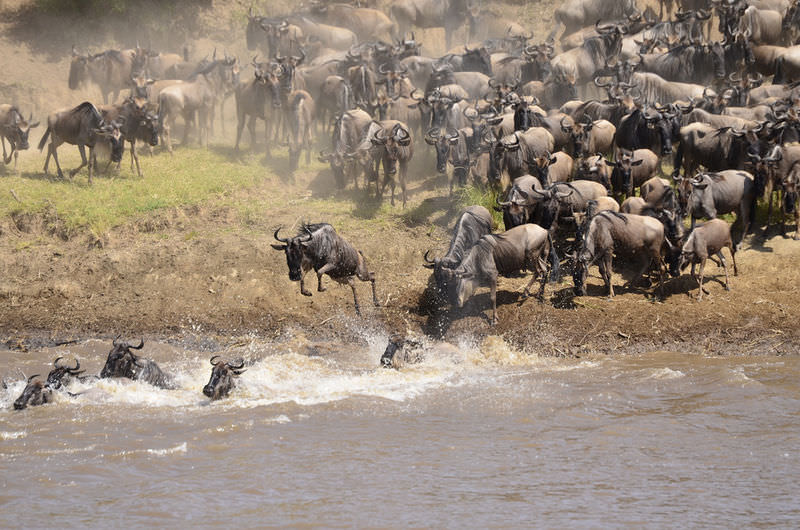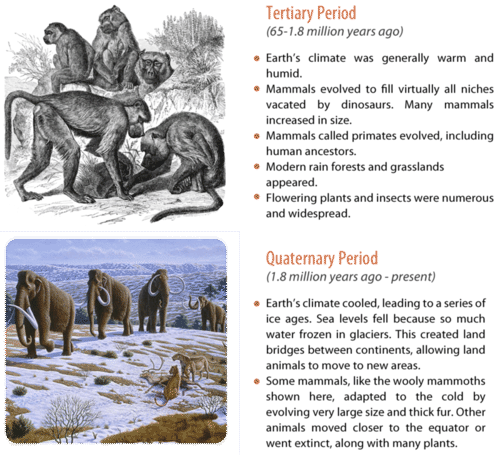What Animals Were In The Cenozoic Era
5.25: Cenozoic Era
- Page ID
- 12101

What allowed mammals to outlast the dinosaurs?
With dinosaurs around, mammals could not thrive. It took a catastrophic consequence to rid the planet of dinosaurs. Luckily for mammals, the extinction of the dinosaurs left many opportunities for mammals to have over and flourish.
The Cenozoic Era: Age of Mammals
The Cenozoic Era literally ways the era of "modern life." It is also called the age of mammals. Mammals took advantage of the extinction of the dinosaurs. They flourished and soon became the dominant animals on Earth. Yous can learn more about the evolution of mammals during the Cenozoic at the link below. The Cenozoic began 65 million years ago and continues to the present. It may be divided into the ii periods described in Effigy below.
 1 way of dividing the Cenozoic Era is into the 2 periods described here.
1 way of dividing the Cenozoic Era is into the 2 periods described here. The Tertiary Menstruum: During the Tertiary Menstruation (65–1.8 million years agone), World's climate was generally warm and humid. This allowed mammals to evolve farther and fill virtually all niches vacated by the dinosaurs. Many mammals increased in size. Mammals called primates evolved, including human ancestors. Mod rain forests and grasslands appeared, and flowering plants and insects were numerous and widespread.
The Fourth Period: During the Fourth Period (ane.8 million years agone–nowadays), Earth's climate cooled, leading to a series of ice ages. Sea levels fell because and so much h2o was frozen in glaciers. This created land bridges between continents, allowing land animals to move to new areas. Some mammals, like the woolly mammoths adapted to the cold by evolving very big size and thick fur. Other animals moved closer to the equator or went extinct, along with many plants.
The last ice age concluded about 12,000 years ago. By that fourth dimension, our own species, Homo sapiens , had evolved. Later that, we were witnesses to the unfolding of life's story. Although we don't know all the details of the recent past, it is far less of a mystery than the billions of years that preceded information technology.
KQED: The Last Ice Historic period
Imagine a vast grassy ecosystem covered with herds of elephants, bison, and camels stretching as far as the middle tin encounter. Africa? Maybe. Merely this also describes Northern California at the end of the last Ice Historic period. What happened to all this wild fauna? Were they over-hunted and killed off? Did global warming destroy their populations? Scientists are not sure, but this relatively contempo loss of life does raise many interesting questions.
Summary
- The Cenozoic Era is the age of mammals. They evolved to fill up almost all the niches vacated by dinosaurs.
- The water ice ages of the 4th Menstruum of the Cenozoic led to many extinctions.
- The last ice historic period concluded 12,000 years agone. By that time, Human sapiens had evolved.
Review
- What explains why mammals were able to flourish during Cenozoic Era?
- Create a timeline of major evolutionary events during the Cenozoic Era.
- Hash out climate changes during the Tertiary and Quaternary Periods, and the effects of these changes on geology and vegetation.
Source: https://k12.libretexts.org/Bookshelves/Science_and_Technology/Biology/05%3A_Evolution/5.25%3A_Cenozoic_Era
Posted by: hyerlorge1995.blogspot.com

0 Response to "What Animals Were In The Cenozoic Era"
Post a Comment